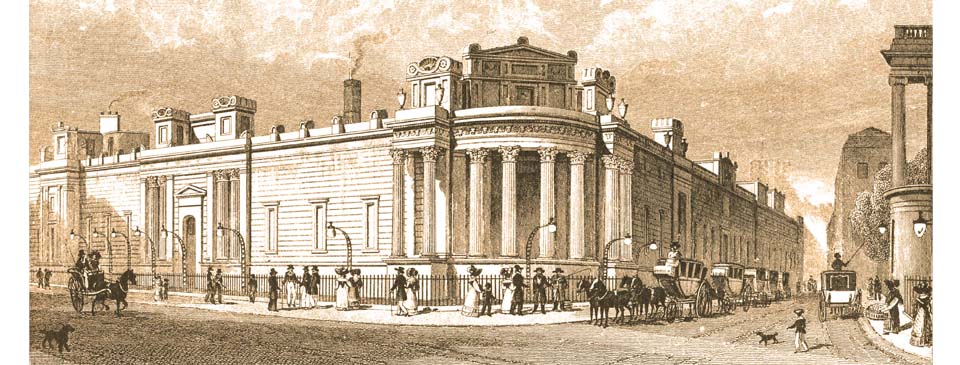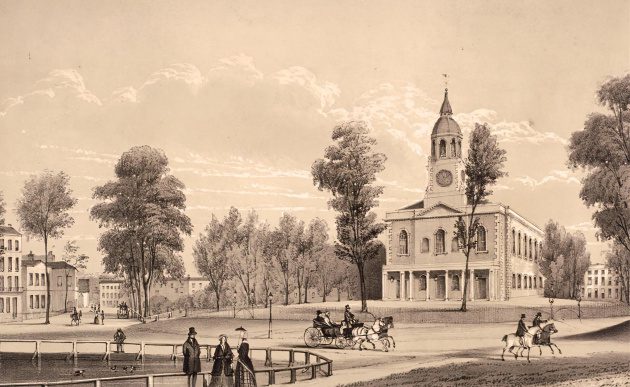In brief – London in the Age of Improvement

The new Bank of England. It had originally opened on the current site in Threadneedle Street in 1734, at what was then the house and garden of its first governor, Sir John Houblon. It was rebuilt between 1788 and 1833 according to the design of Sir John Soane, shown in this picture by Thomas H. Shepherd from 1827. Soane’s building was largely replaced in the 1920s.
London’s suburbs continued to expand with the creation of Brunswick and Mecklenburgh Squares north of Bloomsbury. The development was the first major milestone in the career of James Burton, the most prominent property developer in London of the early 19th century. The large Bedford House was demolished in around 1800 and Russell Square laid out on its former garden. Dorset Square, Fitzroy Square and Euston Square all began in about 1810 on either side of the New Road, then still surrounded by fields. London expanded to meet the village of Islington when the New River Company developed its land around Sadler’s Wells. In the 1820s the developer Thomas Cubitt laid out new streets of housing that joined Euston Square southwards to Bloomsbury. Cubitt also developed the fields around Buckingham House, laying out Belgrave Square and Eaton Square. St. John’s Wood was first laid out in the early 19th century and in 1814 Thomas Lord moved his cricket ground there. Houses were built near Kentish Town on land belonging to the Earl of Camden and so the area became known as Camden Town. Britain’s first veterinary school – later named the Royal Veterinary College – was established there.
Britain’s growing empire and the Industrial Revolution led to a great increase in trade through the Port of London. Hundreds of sailing ships were lined up at any one time, waiting to load and unload. Thefts by workers in the port was so rife that the Marine Police Establishment was created in 1798 to tackle the problem. Operating from a station at Wapping it was the world’s first police force in the modern sense. The work of Henry Fielding at the Bow Street Magistrates Court was continued by his blind half-brother John Fielding, whose detectives became known as the ‘Bow Street Runners’. In 1805 the Bow Street Horse Patrol was established.
During the first decade of the 19th century a number of large new docks were constructed on and either side of the Isle of Dogs peninsula, creating much of the Port of London that survived into the late 20th century. By the end of that decade the West India Docks on the Isle of Dogs, East India Docks at Blackwall, Surrey Docks at Rotherhithe and London Docks at Wapping were in operation. The St. Katharine Docks were constructed in 1828. A new Custom House building was completed in 1816 beside the Tower, replacing Wren’s predecessor.
Three new toll bridges were created as commercial propositions. Vauxhall Bridge, completed in 1816, completed in 1816, was part of a scheme to develop the fields and market gardens on the south side of the Thames into housing. Waterloo Bridge was opened in 1817 on the second anniversary of the battle, and Southwark Bridge in 1819. Neither of the latter two made a profit, with people instead continuing to use the toll-free bridges either side. The initial or final designs for all three bridges were produced by the Scottish engineer John Rennie, who was also responsible for creating the cutting in 1812 that took the Great North Road through Highgate Hill. A suspension bridge was built further upstream on the Thames at Hammersmith.
At the start of the 19th century there were four theatres operating in London. The Theatre Royal, Covent Garden was destroyed by fire in 1808 and eventually rebuilt, reopening in Bow Street in 1811. The Drury Lane Theatre was remodeled, with the portico and other interior features still remaining today. The Theatre Royal, Haymarket was moved slightly to the south and the Opera House in the Haymarket – today’s Her Majesty’s Theatre – was rebuilt, both part of John Nash’s creation of Regent’s Street. A fifth theatre, the Royal Coburg, opened at the corner of The Cut and Waterloo Road in Lambeth in 1816 (renamed the Royal Victoria in 1833).


